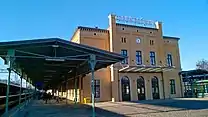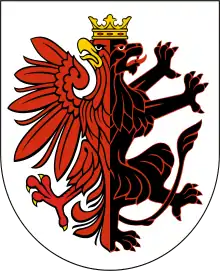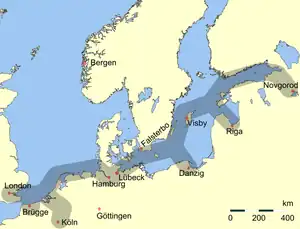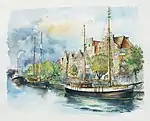Toruń
Toruń[lower-alpha 1] is a city on the Vistula River in north-central Poland and a UNESCO World Heritage Site. Its population was 196,935 as of December 2021.[1] Previously, it was the capital of the Toruń Voivodeship (1975–1998) and the Pomeranian Voivodeship (1921–1945). Since 1999, Toruń has been a seat of the local government of the Kuyavian-Pomeranian Voivodeship and is one of its two capitals, together with Bydgoszcz. The cities and neighboring counties form the Bydgoszcz–Toruń twin city metropolitan area.
Toruń | |
|---|---|
| |
 Flag  Coat of arms | |
| Nickname(s): City of Angels, Gingerbread city, Copernicus Town | |
| Motto: "Durabo" (Latin: "I will endure") | |
 Toruń 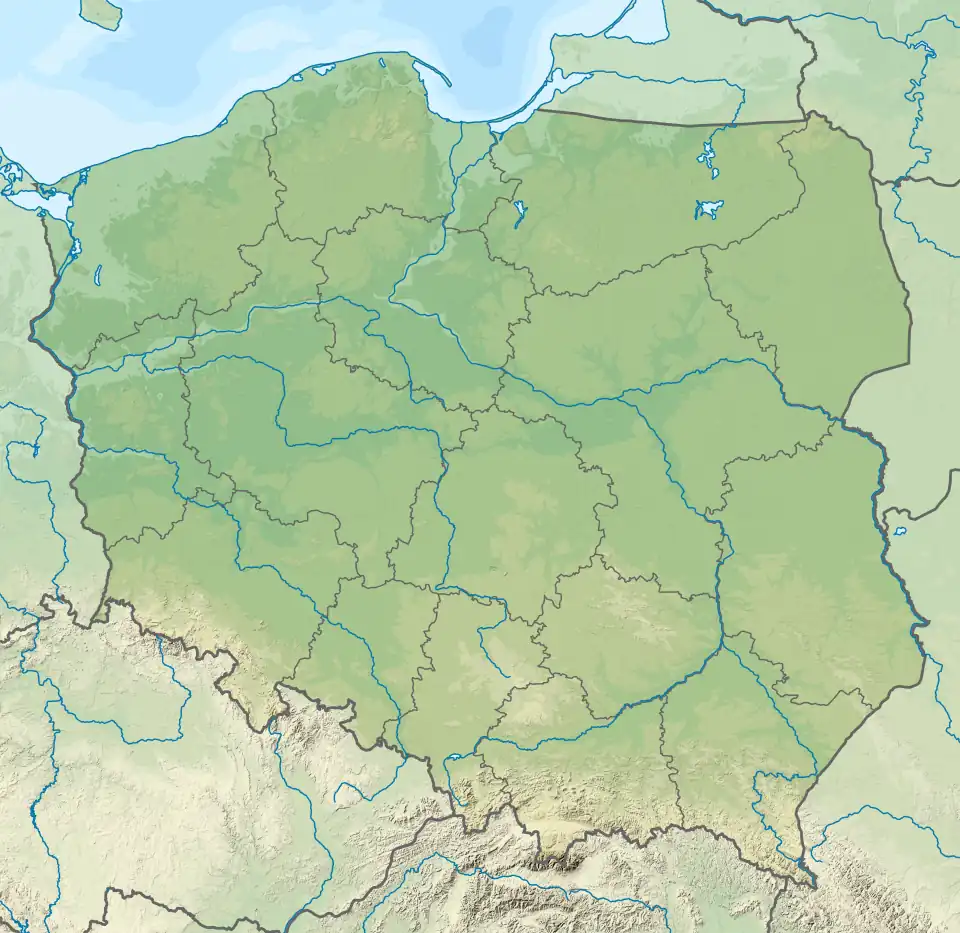 Toruń  Toruń | |
| Coordinates: 53°01′20″N 18°36′40″E | |
| Country | |
| Voivodeship | |
| Established | 8th century |
| City rights | 1233 |
| Government | |
| • City mayor | Michał Zaleski |
| Area | |
| • City | 115.75 km2 (44.69 sq mi) |
| Elevation | 65 m (213 ft) |
| Population (31 December 2021) | |
| • City | 196,935 |
| • Density | 1,716/km2 (4,440/sq mi) |
| • Metro | 297,646 |
| Time zone | UTC+1 (CET) |
| • Summer (DST) | UTC+2 (CEST) |
| Postal code | 87-100 to 87-120 |
| Area code | +48 56 |
| Car plates | CT |
| Highways | |
| Website | http://www.torun.pl/ |
| Official name | Medieval Town of Toruń |
| Type | Cultural |
| Criteria | ii, iv |
| Designated | 1997 |
| Reference no. | 835 |
| UNESCO region | Europe |
Toruń is one of the oldest cities in Poland; it was first settled in the 8th century and in 1233 was expanded by the Teutonic Knights.[6] For centuries it was home to people of diverse backgrounds and religions. From 1264 until 1411, Toruń was part of the Hanseatic League and by the 17th century a leading trading point, which greatly affected the city's architecture, ranging from Brick Gothic to Mannerist and Baroque.
In the Early Modern period, Toruń was a royal city of Poland and one of Poland's four largest cities.[7] With the partitions of Poland in the late 18th century, it became part of Prussia, then of the short-lived Duchy of Warsaw, serving as the temporary Polish capital in 1809,[8] then again of Prussia, of the German Empire and, after World War I, of the reborn Polish Republic. During the Second World War, Toruń was spared bombing and destruction; its Old Town and iconic central marketplace have been entirely preserved.[9]
Toruń is renowned for its Museum of Gingerbread – the gingerbread-baking tradition dates back nearly a millennium – as well as for its large Cathedral. Toruń is noted for its very high standard of living and quality of life.[10] In 1997 the medieval part of the city was designated a UNESCO World Heritage Site. In 2007 the Old Town of Toruń was added to the list of Seven Wonders of Poland.
History
Middle Ages
The first settlement in the vicinity of Toruń is dated by archaeologists to 1100 BC (Lusatian culture).[11] During early medieval times, in the 7th through 13th centuries, it was the location of an old Slavonic settlement,[12] at a ford in the Vistula river. In the 10th century it became part of the emerging Polish state ruled by the Piast dynasty.

In spring 1231 the Teutonic Knights crossed the river Vistula at the height of Nieszawa and established a fortress. On 28 December 1233, the Teutonic Knights Hermann von Salza and Hermann Balk,[13] signed the city charters for Toruń (Thorn) and Chełmno (Kulm). The original document was lost in 1244. The set of rights in general is known as Kulm law. In 1236, due to frequent flooding,[14] it was relocated to the present site of the Old Town. In 1239 Franciscan friars settled in the city, followed in 1263 by Dominicans. In 1264 the adjacent New Town was founded predominantly to house Torun's growing population of craftsmen and artisans, who predominantly came from German-speaking lands.[15] In 1280, the city (or as it was then, both cities) joined the mercantile Hanseatic League, and thus became an important medieval trade centre.
The city was recaptured by Poland in 1410 during the Polish–Lithuanian–Teutonic War however, after the First Peace of Thorn was signed in the city in February 1411, the city fell back to the Teutonic Order. In 1411, the city left the Hanseatic League. In the 1420s, Polish King Władysław II Jagiełło built the Dybów Castle, located in present-day left-bank Toruń, which he visited numerous times.[16] During the next big Polish–Teutonic War, the Dybów Castle was occupied by the Teutonic Knights from 1431 to 1435.[16]

In 1440, the gentry of Thorn co-founded the Prussian Confederation to further oppose the Knights' policies. From 1452, talks between the Polish King Casimir IV Jagiellon and the burghers of the Confederation were held in the Dybów Castle.[16] The Confederation rose against the Monastic state of the Teutonic Knights in 1454 and its delegation submitted a petition to Polish King Casimir IV Jagiellon asking him to regain power over the region as the rightful ruler. An act of incorporation was signed in Kraków (6 March 1454), recognizing the region (including Toruń), as part[17] of the Polish Kingdom. These events led to the Thirteen Years' War. The citizens of the city enraged by the Order's ruthless exploitation, conquered the Teutonic castle, and dismantled the fortifications brick by brick, except for the Gdanisko tower which was used until the 18th century for the gunpowder storage.[18][19] The local mayor pledged allegiance to the Polish King during the incorporation in March 1454 in Kraków,[20] and then in May 1454, an official ceremony was held in Toruń, during which the nobility, knights, landowners, mayors and local officials from Chełmno Land, including Toruń, again solemnly swore allegiance to the Polish King and the Kingdom of Poland.[21] Since 1454, the city was authorized by King Casimir IV to mint Polish coins.[22] During the war, Casimir IV often stayed at the Dybów Castle[23] and Toruń financially supported the Polish Army. The New and Old Towns amalgamated in 1454. The Thirteen Years' War ended in 1466, with the Second Peace of Thorn, in which the Teutonic Order renounced any claims to the city and recognised it as part of Poland.[24] The Polish King granted the town great privileges, similar to those of Gdańsk. Also in 1454, in the Dybów Castle, the King issued the famous Statutes of Nieszawa, covering a set of privileges for the Polish nobility; an event that is regarded as the birth of the noble democracy in Poland, which lasted until the country's demise in 1795.

Early modern period

Throughout history, the city was home to notable personas, scholars and statesmen. In 1473, Nicolaus Copernicus was born, and, in 1501, Polish King John I Albert died in Toruń; his heart was buried inside St. John's Cathedral. In 1500, the Tuba Dei, which was the largest church bell in Poland at that time, was placed in the church of St. John the Baptist, and a bridge across the Vistula was built, which was the country's longest wooden bridge at that time. In 1506, Toruń became a royal city of Poland. In 1528, the royal mint started operating in Toruń. In 1568, a gymnasium was founded, which after 1594 became one of the leading schools of northern Poland for the centuries to come.[25] Also in 1594, the Toruń's first museum (Musaeum) was established at the school, beginning the city's museal traditions. A city of great wealth and influence, it enjoyed voting rights during the royal election period.[26] Sejms of the Polish–Lithuanian Commonwealth were held in Toruń in 1576 and 1626.[27]

In 1557, during the Protestant Reformation, the city adopted Protestantism. Under Mayor Henryk Stroband (1586–1609), the city became centralized. Administrative power passed into the hands of the city council. In 1595, Jesuits arrived to promote the Counter-Reformation, taking control of St John's Church. The Protestant city officials tried to limit the influx of Catholics into the city, as Catholics (Jesuits and Dominican friars) already controlled most of the churches, leaving only St Mary's to Protestant citizens. In 1645, at a time when religious conflicts occurred in many other European countries and the disastrous Thirty Years' War was fought west of Poland, in Toruń, on the initiative of King Władysław IV Vasa, a three-month congress of European Catholics, Lutherans and Calvinists was held, known as Colloquium Charitativum; an important event in the history of interreligious dialogue.[28]
During the Great Northern War (1700–21), the city was besieged by Swedish troops. The restoration of Augustus II the Strong as King of Poland was prepared in the city in the Treaty of Thorn (1709) by Russian Tsar Peter the Great. In the second half of the 17th century, tensions between Catholics and Protestants grew, similarly to religious wars throughout Europe. In the early 18th century about 50 percent of the populace, especially the gentry and middle class, were German-speaking Protestants, while the other 50 percent were Polish-speaking Roman Catholics.[29] Protestant influence was subsequently pushed back after the Tumult of Thorn of 1724.
_fasada.jpg.webp)
Late modern period (from 1793)
After the Second Partition of Poland in 1793, the city was annexed by Prussia. It was briefly regained by Poles as part of the Duchy of Warsaw in years 1807–1815, even serving as the temporary capital in April and May 1809.[8] During these years the city began to attract a growing Jewish community.[30] In 1809, Toruń was successfully defended by the Poles against the Austrians. After being re-annexed by Prussia in 1815, Toruń was subjected to Germanisation and became a strong center of Polish resistance against such policies. The city's first synagogue was inaugurated in 1847.[30] New Polish institutions were established, such as Towarzystwo Naukowe w Toruniu (Toruń Scientific Society), a major Polish institution in the Prussian Partition of Poland, founded in 1875. After World War I, Poland declared independence and regained control over the city. In interwar Poland, Toruń was capital of the Pomeranian Voivodeship.
World War II

During World War II, Germany occupied the city from 7 September 1939 to 1 February 1945. The Einsatzkommando 16 entered the city to commit various crimes against Poles.[31] Under German occupation, local people were subjected to arrests, expulsions, slave labor, deportations to concentration camps and executions, especially the Polish elites as part of the Intelligenzaktion.
A group of Polish railwaymen and policemen from Toruń were murdered by the German gendarmerie and Wehrmacht in Gąbin on 19–21 September 1939.[32] Local Poles, including activists, teachers and priests, arrested in Toruń and the Toruń County from September 1939, were initially held in the pre-war prison, and after its overcrowding, from October 1939, the Germans imprisoned Poles in Fort VII of the Toruń Fortress.[33] Only on 17–19 October 1939, the German police and Selbstschutz arrested 1,200 Poles in Toruń and the county.[33] In early November 1939, the Germans carried out further mass arrests of Polish teachers, farmers and priests in Toruń and the county, who were then imprisoned in Fort VII.[33] Imprisoned Poles were then either deported to concentration camps or murdered on the site.[33] Large massacres of over 1,100 Poles from the city and region, including teachers, school principals, local officials, restaurateurs, shop owners, merchants, farmers, railwaymen, policemen, craftsmen, students, priests, workers, doctors, were carried out in the present-day district of Barbarka.[34] Six mass graves were discovered after the war, in five of which the bodies of the victims were burnt, as the Germans tried to cover up the crime.[35] Local teachers were also among Polish teachers murdered in the Sachsenhausen-Oranienburg, Mauthausen and Dachau concentration camps.[36] Despite such circumstances, the Polish resistance movement was active in the city, and Toruń was the seat of one of the six main commands of the Union of Armed Struggle in occupied Poland (alongside Warsaw, Kraków, Poznań, Białystok and Lwów).[37]
During the occupation, Germany established and operated the Stalag XX-A prisoner-of-war camp in the city with multiple forced labour subcamps in the region, in which Polish, British, French, Australian and Soviet POWs were held. From 1940 to 1943, in the northern part of the city there was a German transit camp Umsiedlungslager Thorn for Poles expelled from Toruń and the surrounding area, which became infamous for inhuman sanitary conditions.[38] Over 12,000 Poles passed through the camp, and around 1,000 died there, including about 400 children.[38] From 1941 to 1945, a German forced labour camp was located in the city.[39] In the spring of 1942, the Germans murdered 30 Polish scouts aged 13–16 in Fort VII.[40]
While the city's population suffered many atrocities, as described, there were no battles or bombings that damaged its buildings. Thus, the city avoided damage during both World Wars, due to which it retained its historic architecture ranging from Gothic through Renaissance and Baroque to the 19th and 20th century styles.
Sights
Listed on the UNESCO list of World Heritage Sites since 1997, Toruń has many monuments of architecture dating back to the Middle Ages. The city is famous for having preserved almost intact its medieval spatial layout and many Gothic buildings, all built from brick, including monumental churches, the Town Hall and many burgher houses.
Gothic architecture
Toruń has the largest number of preserved Gothic houses in Poland, many with Gothic wall paintings or wood-beam ceilings from the 16th to the 18th centuries.
- The Cathedral of SS. John the Evangelist and John the Baptist, an aisled hall church built in the 14th century and extended in the 15th century; outstanding Gothic sculptures and paintings inside (Moses, St. Mary Magdalene, gravestone of Johann von Soest), Renaissance and Baroque epitaphs and altars (among them the epitaph of Copernicus from 1580), as well as the Tuba Dei, the largest medieval church bell in Poland and one of the largest in Europe
- St. Mary's church, a formerly Franciscan aisled hall built in the 14th century
- St. James the Greater's church (often mistakenly called St Jacob's), a basilica from the 14th century, with monumental wall paintings and Gothic stalls
- The Old Town Hall was inaugurated in 1274, than extended and rebuilt between 1391 and 1399, and extended again at the end of the 16th century; considered one of the most monumental town halls in Central Europe (Toruń Regional Museum or Muzeum Okręgowe in Polish)
- City fortifications, begun in the 13th century, extended between the 14th and 15th centuries, mostly demolished in the 19th century, but partially preserved with a few city gates and watchtowers (among them the so-called Leaning Tower) from the Vistula side. See also: Toruń Fortress
- A 15th-century Gothic house (now a museum) where Copernicus was reputedly born
- Ruins of 13th-century Teutonic Knights' castle
- House at the sign of the Star (Polish: Kamienica Pod Gwiazdą, the East Asian Museum, previously Gothic, briefly owned by Filip Callimachus, then rebuilt in the 16th century and in 1697, with a richly decorated stucco façade and wooden spiral stairs.
Toruń, unlike many other historic cities in Poland, escaped substantial destruction in World War II. Particularly left intact was the Old Town, all of whose important architectural monuments are originals, not reconstructions.
Major renovation projects have been undertaken in recent years to improve the condition and external presentation of the Old Town. Besides the renovation of various buildings, projects such as the reconstruction of the pavement of the streets and squares (reversing them to their historical appearance), and the introduction of new plants, trees and objects of 'small architecture', are underway.
Numerous buildings and other constructions, including the city walls along the boulevard, are illuminated at night, creating an impressive effect - probably unique among Polish cities with respect to the size of Toruń's Old Town and the scale of the illumination project itself.
Toruń is also home to the Zoo and Botanical Garden opened in 1965 and 1797 respectively and is one of the city's popular tourist attractions.
Districts
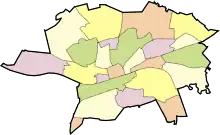
Toruń is divided into 24 administrative districts (dzielnica) or boroughs, each with a degree of autonomy within its own municipal government. The Districts include: Barbarka, Bielany, Bielawy, Bydgoskie Przedmieście, Chełmińskie Przedmieście, Czerniewice, Glinki, Grębocin nad Strugą, Jakubskie Przedmieście, Kaszczorek, Katarzynka, Koniuchy, Mokre, Na Skarpie, Piaski, Podgórz, Rubinkowo, Rudak, Rybaki, Stare Miasto (Old Town), Starotoruńskie Przedmieście, Stawki, Winnica, Wrzosy.
Symbols
The colors of Toruń are white and blue in the horizontal arrangement, white top, blue bottom, equal in size. The flag of the city of Toruń is a bipartite sheet. The upper field is white, the lower field is blue. If the flag is hung vertically, the upper edge of the flag must be on the left.[41]
The flag with the coat of arms is also in use. The ratio of the height of the coat of arms to the width of the flag is 1:2.[42]
Climate
The climate can be described as humid continental (Köppen: Dfb) if the isotherm of 0 °C (32 °F) is used or an oceanic climate (Cfb) if the −3 °C (27 °F) isotherm is adopted. Back in 1930s, the city passed close to the original boundary and dividing line of climates C and D groups in the north–south direction proposed by climatologist Wladimir Köppen.[43] Toruń is in the transition between the milder climates of the west and north of the Poland and the more extreme ones like the south (warmer summer) and the east (colder winter). It is not much different from the climates of more southerly Kraków[44] and easterly Warsaw,[45] though it has slightly milder winters and more moderate summers.[46][47]
Being close to definitely continental climates, it has a high variability caused by the contact of eastern continental air masses and western oceanic ones. This is influenced by the geographical location of the city – the Toruń Basin to the south, and the Vistula Valley to the north.[48]
| Climate data for Toruń (St. Joseph), elevation: 69 m, 1991-2020 normals, extremes 1951–present | |||||||||||||
|---|---|---|---|---|---|---|---|---|---|---|---|---|---|
| Month | Jan | Feb | Mar | Apr | May | Jun | Jul | Aug | Sep | Oct | Nov | Dec | Year |
| Record high °C (°F) | 12.8 (55.0) |
17.1 (62.8) |
23.4 (74.1) |
31.2 (88.2) |
32.3 (90.1) |
36.6 (97.9) |
38.2 (100.8) |
37.5 (99.5) |
35.1 (95.2) |
28.2 (82.8) |
19.9 (67.8) |
15.6 (60.1) |
38.2 (100.8) |
| Average high °C (°F) | 1.4 (34.5) |
3.2 (37.8) |
7.6 (45.7) |
14.6 (58.3) |
19.8 (67.6) |
23.0 (73.4) |
25.1 (77.2) |
24.9 (76.8) |
19.3 (66.7) |
13.1 (55.6) |
6.6 (43.9) |
2.7 (36.9) |
13.4 (56.1) |
| Daily mean °C (°F) | −1.1 (30.0) |
−0.1 (31.8) |
3.2 (37.8) |
8.8 (47.8) |
13.8 (56.8) |
17.1 (62.8) |
19.3 (66.7) |
18.9 (66.0) |
13.9 (57.0) |
8.7 (47.7) |
4.0 (39.2) |
0.4 (32.7) |
8.9 (48.0) |
| Average low °C (°F) | −3.8 (25.2) |
−3.1 (26.4) |
−0.9 (30.4) |
3.1 (37.6) |
7.8 (46.0) |
11.3 (52.3) |
13.6 (56.5) |
13.2 (55.8) |
9.1 (48.4) |
5.0 (41.0) |
1.5 (34.7) |
−2.1 (28.2) |
4.6 (40.3) |
| Record low °C (°F) | −32.4 (−26.3) |
−29.3 (−20.7) |
−26.5 (−15.7) |
−8.6 (16.5) |
−7.2 (19.0) |
−1.4 (29.5) |
3.1 (37.6) |
1.4 (34.5) |
−3.7 (25.3) |
−10.1 (13.8) |
−22.8 (−9.0) |
−24.5 (−12.1) |
−32.4 (−26.3) |
| Average precipitation mm (inches) | 32.7 (1.29) |
27.3 (1.07) |
32.2 (1.27) |
29.6 (1.17) |
51.2 (2.02) |
55.7 (2.19) |
90.6 (3.57) |
63.9 (2.52) |
55.8 (2.20) |
37.9 (1.49) |
33.5 (1.32) |
38.5 (1.52) |
548.8 (21.61) |
| Average extreme snow depth cm (inches) | 6.1 (2.4) |
5.7 (2.2) |
3.0 (1.2) |
1.1 (0.4) |
0.0 (0.0) |
0.0 (0.0) |
0.0 (0.0) |
0.0 (0.0) |
0.0 (0.0) |
0.0 (0.0) |
1.5 (0.6) |
4.2 (1.7) |
6.1 (2.4) |
| Average precipitation days (≥ 0.1 mm) | 16.07 | 13.30 | 13.33 | 10.73 | 12.83 | 13.47 | 13.63 | 12.53 | 11.63 | 12.73 | 14.27 | 16.27 | 160.80 |
| Average snowy days (≥ 0 cm) | 14.8 | 12.1 | 5.4 | 0.5 | 0.0 | 0.0 | 0.0 | 0.0 | 0.0 | 0.0 | 2.3 | 9.1 | 44.2 |
| Average relative humidity (%) | 87.1 | 83.2 | 76.7 | 68.3 | 67.8 | 68.9 | 70.2 | 70.7 | 77.8 | 83.1 | 89.0 | 88.9 | 77.6 |
| Mean monthly sunshine hours | 44.7 | 68.2 | 124.0 | 196.1 | 244.0 | 237.4 | 239.2 | 233.5 | 157.3 | 106.7 | 44.2 | 34.9 | 1,730.1 |
| Source 1: Institute of Meteorology and Water Management[49][50][51][52][53][54][55][56] | |||||||||||||
| Source 2: Meteomodel.pl (records, relative humidity 1991–2020)[57][58][59] | |||||||||||||
Demographics
| Year | Pop. | ±% |
|---|---|---|
| 1950 | 75,734 | — |
| 1960 | 104,800 | +38.4% |
| 1970 | 129,400 | +23.5% |
| 1980 | 174,400 | +34.8% |
| 1990 | 199,600 | +14.4% |
| 2000 | 210,194 | +5.3% |
| 2010 | 205,312 | −2.3% |
| 2020 | 198,613 | −3.3% |
| source [60] | ||
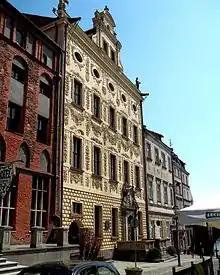
The most recent statistics show a decrease in the population of the city, from 211,169 in 2001 (highest) to 202,562 in 2018. Among the demographic trends influencing this decline, are: suburbanisation, migration to larger urban centres, and wider trends observed in the whole of Poland such as general population decline, slowed down by immigration in 2017. The birth rate in the city in 2017 was 0.75. Low birthrates have been consistent in the city for the first two decades of 21st Century.
The official forecasts from Statistics Poland state that by 2050 the city population will have declined to 157,949.
Inside the city itself, most of the population is concentrated on the right (northern) bank of the Vistula river. Two of the most densely populated areas are Rubinkowo and Na Skarpie, housing projects built mostly in the 1970s and 1980s, located between the central and easternmost districts; their total population is about 70,000.
The Bydgoszcz–Toruń metro area of Toruń and Bydgoszcz, their counties, and a number of smaller towns, may in total have a population of as much as 800,000. Thus the area contains about one third of the population of the Kuyavia-Pomerania region (which has about 2.1 million inhabitants).
Transport
The transport network in the city has undergone major development in recent years. The partial completion of ring road (East and South), the completion of the second bridge (2013) and various road, and cycling lane improvements, including construction of Trasa Średnicowa, have decidedly improved the traffic in the city. However, noise barriers that have been erected along the new or refurbished roads have been criticised as not conducive to a beautiful urban landscape. The extensive roadworks have also drawn attention to the declining population numbers, casting doubt that the city might over-delivered for the future number of road users, as the demographic trends forecast from Statistics Poland predicts a reduction of population by almost 1/4 by year 2050.[61]
The city's public transport system comprises five tram lines and about 40 bus routes, covering the city and some of the neighboring communities.
Toruń is situated at a major road junction, one of the most important in Poland. The A1 highway reaches Toruń, and a southern beltway surrounds the city. Besides these, the European route E75 and a number of domestic roads (numbered 10, 15, and 80) run through the city.
With three main railway stations (Toruń Główny, Toruń Miasto and Toruń Wschodni), the city is a major rail junction, with two important lines crossing there (Warszawa–Bydgoszcz and Wrocław–Olsztyn). Two other lines stem from Toruń, toward Malbork and Sierpc.

The rail connection with Bydgoszcz is run under a name "BiT City" as a "metropolitan rail". Its main purpose is to allow traveling between and within these cities using one ticket. A joint venture of Toruń, Bydgoszcz, Solec Kujawski and the voivodeship, it is considered as important in integrating Bydgoszcz-Toruń metropolitan area. A major modernization of BiT City railroute, as well as a purchase of completely new vehicles to serve the line, is planned for 2008 and 2009. Technically, it will allow to travel between Toruń-East and Bydgoszcz-Airport stations at a speed of 120 km/h (75 mph) in a time of approximately half an hour. In a few years' time "BiT City" will be integrated with local transportation systems of Toruń and Bydgoszcz, thus creating a uniform metropolitan transportation network – with all necessary funds having been secured in 2008.
Since September 2008, the "one-ticket" solution has been introduced also as regards a rail connection with Włocławek, as a "regional ticket". The same is planned for connection with Grudziądz.
Two bus depots serve to connect the city with other towns and cities in Poland.
As of 2008, a small sport airfield exists in Toruń; however, a modernization of the airport is seriously considered with a number of investors interested in it. Independently of this, Bydgoszcz Ignacy Jan Paderewski Airport, located about 50 kilometres (31 miles) from Toruń city centre, serves the whole Bydgoszcz-Toruń metropolitan area, with a number of regular flights to European cities.
Economy

Although a medium-sized city, Toruń is the site of the headquarters of some of the largest companies in Poland, or at least of their subsidiaries. The official unemployment rate, as of September 2008, is 5.4%.
In 2006, construction of new plants owned by Sharp Corporation and other companies of mainly Japanese origin has started in the neighboring community of Łysomice - about 10 kilometres (6 miles) from city centre. The facilities under construction are located in a newly created special economic zone. As a result of cooperation of the companies mentioned above, a vast high-tech complex is to be constructed in the next few years, providing as many as 10,000 jobs (a prediction for ) at the cost of about 450 million euros. As of 2008, the creation of another special economic zone is being considered, this time inside city limits.

Thanks to its architectural heritage Toruń is visited by more than 1.5 million tourists a year (1.6 million in 2007). This makes tourism an important branch of the local economy, although time spent in the city by individual tourists or the number of hotels, which can serve them, are still not considered satisfactory. Major investments in renovation of the city's monuments, building new hotels (including high-standard ones), improvement in promotion, as well as launching new cultural and scientific events and facilities, give very good prospects for Toruń's tourism.

In recent years Toruń has been a site of intense building construction investments, mainly residential and in its transportation network. The latter has been possible partly due to the use of European Union funds assigned for new member states. Toruń city county generates by far the highest number of new dwellings built each year among all Kuyavian-Pomeranian counties, both relative to its population as well as in absolute values. It has led to almost complete rebuilding of some districts. As of 2008, many major constructions are either under development or are to be launched soon - the value of some of them exceeding 100 million euros. They include a new speedway stadium, major shopping and entertainment centres, a commercial complex popularly called a "New Centre of Toruń", a music theater, a centre of contemporary art, hotels, office buildings, facilities for the Nicolaus Copernicus University, roads and tram routes, sewage and fresh water delivery systems, residential projects, the possibility of a new bridge over the Vistula, and more. Construction of the A1 motorway and the BiT City fast metropolitan railway also directly affects the city. About 25,000 local firms are registered in Toruń.
Culture

Toruń has two drama theatres (Teatr im. Wilama Horzycy with three stages and Teatr Wiczy), two children's theatres (Baj Pomorski and Zaczarowany Świat), two music theatres (Mała Rewia, Studencki Teatr Tańca), and numerous other theatre groups. The city hosts, among others events, the international theatre festival, "Kontakt", annually in May.
A building called Baj Pomorski has recently been completely reconstructed. It is now one of the most modern cultural facilities in the city, with its front elevation in the shape of a gigantic chest of drawers. It is located at the south-east edge of the Old Town. Toruń has two cinemas including a Cinema City, which has over 2,000 seats.
Over ten major museums document the history of Toruń and the region. Among others, the "House of Kopernik" and the accompanying museum commemorate Nicolaus Copernicus and his revolutionary work, the university museum reveals the history of the city's academic past.
_2010-07-17_026.jpg.webp)
The Tony Halik Travelers' Museum (Muzeum Podróżników im. Tony Halika) was established in 2003 after Elżbieta Dzikowska donated to citizens of Toruń a collection of objects from various countries and cultures following the death of her husband, famous explorer and writer, Toruń native, Tony Halik. It is managed by the District Museum in Toruń.
The Centre of Contemporary Art (Centrum Sztuki Współczesnej - CSW) opened in June 2008 and is one of the most important cultural facilities of this kind in Poland. The modern building is located in the very centre of the city, adjacent to the Old Town. The Toruń Symphonic Orchestra (formerly the Toruń Chamber Orchestra) is well-rooted in the Toruń cultural landscape.
Toruń is home to a planetarium (located downtown) and an astronomical observatory (located in nearby village of Piwnice). The latter boasts the largest radio telescope in Central Europe with a diameter of 32 m (104.99 ft), second only to the Effelsberg 100 m (328.08 ft) radio telescope.
Toruń is well known for Toruń gingerbread, a type of piernik often made in elaborate molds. Muzeum Piernika in Toruń is Europe's only museum dedicated to gingerbread.[62] The 15-year-old composer Fryderyk Chopin was smitten with Toruń gingerbread when he visited his godfather, Fryderyk Skarbek, there in the summer of 1825.
Toruń is a center of conservative Roman Catholic culture. Redemptorist Tadeusz Rydzyk has organized here Radio Maryja, Telewizja Trwam, a college whose students contribute to the mentioned media.[63] Now a museum is being constructed.
The 12999 Toruń asteroid is named after the city.
Education

Over thirty elementary and primary schools and over ten high schools make up the educational base of Toruń. Besides these, students can also attend a handful of private schools.

The largest institution of higher education in Toruń, Nicolaus Copernicus University in Toruń serves over 20 thousand students and was founded in 1945, based on the Toruń Scientific Society, Stefan Batory University in Wilno, and Jan Kazimierz University in Lwów. The existence of a high-ranked and high-profiled university with so many students plays a great role the city's position and importance in general, as well as in creating an image of Toruń's streets and clubs filled with crowds of young people. It also has a serious influence on local economy.
Other public institutions of higher education:
- Wyższe Seminarium Duchowne (a section of the Theological Faculty of the Nicolaus Copernicus University)
- The Teacher Training College - Nauczycielskie Kolegium Języków Obcych (affiliated to the Nicolaus Copernicus University)
- College of Fashion (Kolegium Mody)
- University of Warmia and Mazury in Olsztyn - Faculty of Geodesy and Land Management Department in Toruń
- College of Social Work - Kolegium Pracowników Służb Społecznych
- University of Gdańsk - College of Language

There are also a number of private higher education facilities:
- WSB Universities - WSB University in Toruń[64]
- The University of Social & Medial Culture in Toruń - Wyższa Szkoła Kultury Społecznej i Medialnej (affiliate to the Radio Maryja)
- Toruńska Szkoła Wyższa
- Wyższa Szkoła Filologii Hebrajskiej (Higher School of Hebrew Philology)
- Toruń School of Entrepreneurship - Toruńska Wyższa Szkoła Przedsiębiorczości
Also located in Toruń is one of the oldest high schools in Poland, I Liceum Ogólnokształcące im. Mikołaja Kopernika, which dates back to a gymnasium founded in 1568.[25]
Healthcare

Six hospitals of various specializations provide medical service for Toruń itself, its surrounding area and to the region in general. The two largest of these hospitals, recently run by the voivodeship, are to be taken over by Nicolaus Copernicus University and run as its clinical units. At least one of them is to change its status in 2008, with the formal procedures being very advanced.
In addition, there are a number of other healthcare facilities in the city.
Media
- Press
- daily newspapers: Nasz Dziennik, Rzeczpospolita, Gazeta Wyborcza Toruń, Gazeta Pomorska, Nowości, Metro
- Weekly magazines: Niedziela, City Toruń, Teraz Toruń
- Other: Undergrunt, Immuniet, Ilustrator, Poza Toruń
- Radio Stations:
- Polskie Radio Pomorza i Kujaw,
- Radio ESKA – which plays international hits, along with Polish music
- Radio GRA
- Radio ZET Gold
- Radio Sfera
- Radio WAWA
- RMF FM
- Radio Maryja – a radio station that broadcasts religious observances such as mass and prayer in Polish
- TV Stations:
- TVN/TVN24 – regional office
- TVP Info – Oddział w Bydgoszczy, Redakcja Terenowa w Toruniu,[65]
- Telewizja Trwam
- Podróże TV
- Telewizja Kablowa Toruń
- Telewizja TAT Studio Region
- Telewizja Petrus
Sports

- KS Toruń – motorcycle speedway team, competing in the Speedway Ekstraliga, four times Polish Champions, whose home ground is the MotoArena Toruń
- KS Toruń HSA – ice hockey club which plays in the top hockey league in Poland, 1968 runners-up, 2005 Polish Cup winner
- Elana Toruń – football team, competing in the 4th division in Poland, whose home ground is the Municipal Stadium
- Pomorzanin Toruń – field hockey (premier league in Poland), football (4th division in Poland), boxing
- Twarde Pierniki Polski Cukier Toruń – basketball club, which is competing in the Polish Basketball League (men premier league in Poland), two times runners-up, whose home ground is the Arena Toruń
- Energa Katarzynki Toruń – basketball club, competing in the Basket Liga Kobiet (women premier league in Poland), finishing 3rd in 2010, 2012, 2015, whose home ground is the Arena Toruń
- Angels Toruń – American football – Polish American Football League First Division
- Nestle-Pacyfic – cycling
- Toruński Klub Bowlingowy – bowling
- Budowlani Toruń – volleyball (women premier league in Poland), whose home ground is the Arena Toruń
- UKS Budowlanka Toruń – volleyball
- Toruński KS – defunct Polish football club, co-founders of the Polish football league
- The E11 European long distance path for hikers passes through Toruń
Notable people
_2010-07-17_050.jpg.webp)

Notable residents of Toruń include:
- Filippo Buonaccorsi (1437–1496), Italian humanist, writer, and diplomat
- Nicolaus Copernicus (1473–1543), Renaissance polymath and astronomer.[66]
- Anna Vasa of Sweden (1568–1625), Polish and Swedish princess
- Bartholomeus Strobel (1591–1650), Baroque painter
- Samuel Thomas von Sömmerring (1755–1830), German physician and anatomist
- Samuel Linde (1771–1847), linguist, librarian, and lexicographer of the Polish language
- Fryderyk Skarbek (1792–1866), economist, novelist, historian, social activist, administrator, politician, and penologist
- Zvi Hirsch Kalischer (1795–1874), Orthodox rabbi
- Frédéric Chopin (1810–1849), composer and virtuoso pianist of the Romantic period.[67]
- Julie Wolfthorn (1864–1944), German painter
- Władysław Dziewulski (1878–1962), astronomer and mathematician.
- Hermann Rauschning (1887–1982), German conservative reactionary
- Roman Ingarden (1893–1970), philosopher
- Lotte Jacobi (1896–1990), American portrait photographer and photojournalist
- Elżbieta Zawacka (1909–2009), university professor, scouting instructor, SOE agent, and a freedom fighter during World War II
- Tony Halik (1921–1998), film operator, documentary filmmaker, travel writer, traveller, explorer, and polyglot
- Kazimierz Serocki (1922–1981), composer
- Bodo Tümmler (born 1943), German middle-distance runner
- Aleksander Wolszczan (born 1946), astronomer
- Bogusław Linda (born 1952), actor
- Michał Zaleski (born 1952), politician
- Jadwiga Rappé (born 1952), operatic contralto
- Waldemar Fydrych (born 1953), Polish activist, leader of the Orange Alternative movement
- Jerzy Wenderlich (born 1954), politician
- Joanna Scheuring-Wielgus (born 1972), politician
- Piotr Głowacki (born 1980), actor
- Tomasz Wasilewski (born 1980), film director and screenwriter
- Olga Bołądź (born 1984), actress
- Adrian Kubicki (born 1987), Consul General of the Republic of Poland in New York City[68]
Sport
- Teresa Weyna (born 1950), ice dancer
- Tomasz Warczachowski (born 1974), footballer
- Michał Gołaś (born 1984), road bicycle racer
- Adam Waczyński (born 1989), basketball player
- Michał Kwiatkowski (born 1990), road bicycle racer
- Katarzyna Zillmann (born 1995), rower
- Jakub Piotrowski (born 1997), footballer
International relations
Honouring Toruń's sister relationship with Philadelphia, Pennsylvania, the Bulwar Filadelfijski (Philadelphia Boulevard), a 2 km (1.2 mi) long street running mostly between Vistula River and walls of the Old Town and the boulevard itself, bears its name.

The Ślimak Getyński is one of the lanes connecting Piłsudski Bridge / John Paul II Avenue with Philadelphia Boulevard at their downtown interchange. It honours the relationship with Göttingen, its name derived from the street's half-circular shape (Polish word ślimak meaning "snail").
Twin towns – Sister cities
|
Former twin towns:
 Kaliningrad, Russia (since 1995 until 2022, terminated due to the Russian invasion of Ukraine)[72]
Kaliningrad, Russia (since 1995 until 2022, terminated due to the Russian invasion of Ukraine)[72]
Gallery
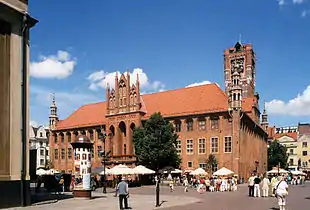 Old Town Hall
Old Town Hall House Under the Star
House Under the Star Holy Spirit Church
Holy Spirit Church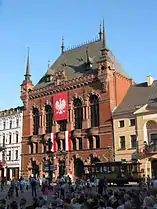 Artus Court
Artus Court.JPG.webp) Caesar's Arch Tenement House
Caesar's Arch Tenement House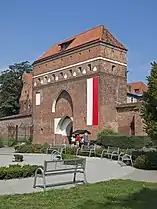 Brama Klasztorna (Convent Gate)
Brama Klasztorna (Convent Gate)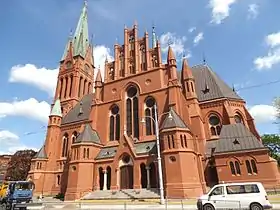 Saint Catherine of Alexandria church
Saint Catherine of Alexandria church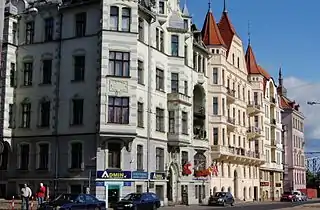 Historic tenement houses along Warszawska Street
Historic tenement houses along Warszawska Street.JPG.webp) Former Police Station Building
Former Police Station Building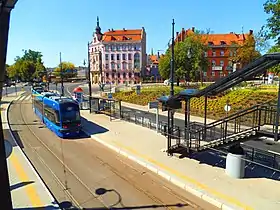
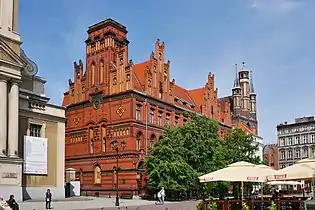 Main Post Office
Main Post Office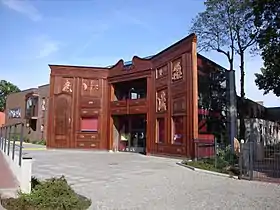
_2010-07-17_053.jpg.webp) Szeroka Street
Szeroka Street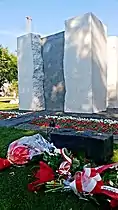 Memorial to the victims of Intelligenzaktion Pommern
Memorial to the victims of Intelligenzaktion Pommern_2010-07-17_024.jpg.webp) Collegium Maius of the Nicolaus Copernicus University
Collegium Maius of the Nicolaus Copernicus University Castle tower and mill
Castle tower and mill
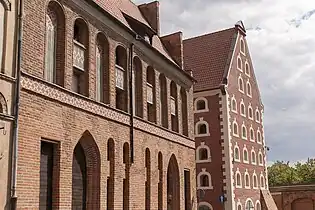 Old granaries in the Old Town
Old granaries in the Old Town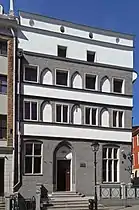 Diocesan Museum
Diocesan Museum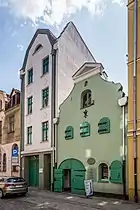 Tony Halik Travelers' Museum
Tony Halik Travelers' Museum.jpg.webp) Gen. Elżbieta Zawacka Bridge
Gen. Elżbieta Zawacka Bridge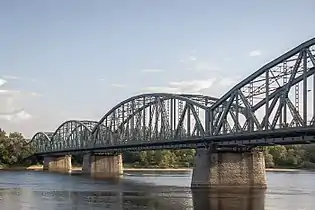 Józef Piłsudski Bridge over the Vistula River
Józef Piłsudski Bridge over the Vistula River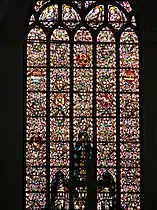 St. Mary's Church
St. Mary's Church
In popular culture
- Thorn (Toruń) is one of the starting towns of the State of the Teutonic Order in the turn-based strategy game Medieval II: Total War: Kingdoms.[73]
- Toruń also makes an appearance in the alternate history RTS Command and Conquer: Red Alert; in the Soviet campaign of the game, the player is tasked on liquidating the city's inhabitants after the Soviet leadership discover resistance fighters had aided escaped test subjects.
See also
Notes
References
- "Local Data Bank". Statistics Poland. Retrieved 21 July 2022. Data for territorial unit 0463000.
- "Toruń". Lexico UK English Dictionary UK English Dictionary. Oxford University Press. Archived from the original on 26 August 2022.
- "Torun". The American Heritage Dictionary of the English Language (5th ed.). HarperCollins. Retrieved 16 August 2019.
- "Toruń". Collins English Dictionary. HarperCollins. Retrieved 16 August 2019.
- "Toruń". Merriam-Webster.com Dictionary. Retrieved 16 August 2019.
- "History of Toruń". www.torun.pl. Retrieved 20 August 2017.
- Maria Bogucka, Miasto i mieszczanin w społeczeństwie Polski nowożytnej XVI-XVIII w., Warsaw 2009
- "Toruń stolicą Polski? Przez trzy tygodnie". Interia Nowa Historia (in Polish). Retrieved 4 October 2019.
- Development, JW Web. "VisitTorun: Torun Guide - Home". Retrieved 7 April 2017.
- "Jakość życia w polskich miastach - ranking - Urbnews.pl". 2 December 2015. Retrieved 7 April 2017.
- Hypothetical reconstruction of a Lusatian culture settlement, built using bronze age tools: Wola Radziszowska, Poland, part of a study by scientists from the Jagiellonian University's Institute of Archaeology.
- Encyklopedia Powszechna PWN Warsaw 1976
- "Krzyżacy - założyciele Torunia" (Teutonic Knights — the founders of Thorn). (Internet Archive) Urząd Miasta Torunia. "The foundation charter for Thorn was signed on 28 December 1233 by the Grand Master of the Teutonic Order Hermann von Salza and the National Master for Prussia and the Slavonic Lands Hermann Balka. In that way Thorn was founded by the Teutonic Order and managed by the Knights until 1454." Retrieved 16 June 2013.
- Max Töppen Historisch-comparative Geographie von Preussen: Nach den Quellen, namentlich auch archivalischen, J. Perthes, 1858; PDF
- Norman Davies (2005). God's Playground A History of Poland Volume 1: The Origins to 1795. Oxford University Press. p. 65.
- Grzeszkiewicz-Kotlewska, Lidia (2002). "Zamek Władysława Jagiełły w Dybowie w świetle badań archeologicznych w latach 1998-2001". Rocznik Toruński (in Polish). Wydawnictwo Naukowe Uniwersytetu Mikołaja Kopernika. 29: 19.
- F. Kiryk, J. Ryś, Wielka Historia polski, t. II, 1320–1506, Kraków 1997, pp. 160–161.
- Torun.pl (2017). "Ruiny Zamku Krzyżackiego" [Remnants of the Teutonic Castle]. Toruńskie Serwisy Miejskie. Urząd Miasta Torunia. Retrieved 12 March 2017.
- Urząd Miasta Torunia (2012). "Krzyżacy - założyciele Torunia" [Teutonic Nights – the founders of town]. Gotyk na dotyk. Archived from the original on 19 January 2012 – via Internet Archive.
- Górski, Karol (1949). Związek Pruski i poddanie się Prus Polsce: zbiór tekstów źródłowych (in Polish). Poznań: Instytut Zachodni. pp. 71–72.
- Górski, p. 76-77
- Górski, p. 63
- Grzeszkiewicz-Kotlewska, p. 19-20
- Górski, p. 88
- "Historia szkoły". I Liceum Ogólnokształcące im. Mikołaja Kopernika w Toruniu (in Polish). Retrieved 4 October 2019.
- Polska Encyklopedia Szlachecka, t. I, Warsaw 1935, p. 42.
- Władysław Konopczyński, Chronologia sejmów polskich 1493–1793.
- "Colloquium Charitativum". Toruński Serwis Turystyczny (in Polish). Retrieved 4 October 2019.
- Bahlcke, Joachim (2008). Daniel Ernst Jablonski; Religion, Wissenschaft und Politik um 1700 (in German). Otto Harrassowitz Verlag. p. 227. ISBN 978-3-447-05793-6.
- "History | Virtual Shtetl".
- Wardzyńska, Maria (2009). Był rok 1939. Operacja niemieckiej policji bezpieczeństwa w Polsce. Intelligenzaktion (in Polish). Warszawa: IPN. p. 61.
- Wardzyńska, p. 97
- Wardzyńska, p. 161
- Wardzyńska, p. 161-163
- Wardzyńska, p. 162
- Wardzyńska, p. 180-181
- Grabowski, Waldemar (2011). "Armia Krajowa". Biuletyn Instytutu Pamięci Narodowej (in Polish). No. 8-9 (129-130). IPN. p. 116. ISSN 1641-9561.
- "Tomasz Ceran "Piekło w fabryce smalcu"" (PDF).
- "Arbeitserziehungslager Thorn". Bundesarchiv.de (in German). Retrieved 21 November 2020.
- Kostkiewicz, Janina (2020). "Niemiecka polityka eksterminacji i germanizacji polskich dzieci w czasie II wojny światowej". In Kostkiewicz, Janina (ed.). Zbrodnia bez kary... Eksterminacja i cierpienie polskich dzieci pod okupacją niemiecką (1939–1945) (in Polish). Kraków: Uniwersytet Jagielloński, Biblioteka Jagiellońska. p. 56.
- "Herb, flaga, hejnał Torunia - Atrakcje Torunia. Przewodnik po Toruniu". www.turystyka.torun.pl (in Polish). Retrieved 10 May 2020.
- "Barwy, flaga, chorągiew | www.torun.pl". www.torun.pl (in Polish). Retrieved 10 May 2020.
- K., Alt, E. Birkeland, B. J. Borchardt, W. Braak, C. Brooks, Charles F. Connor, A. J. Conrad, V. Föyn, N. J. Geiger, R. Kidson, E. Knoch, K. Köppen, W. Loewe, Fritz Meinardus, W. Milankovitch, M. Petersen, Helge Sapper, K. Schott, G. Sverdrup, H. U. Taylor, Griffith Wagner, A. Ward, Robert DeC. Wegener (1936). Handbuch der Klimatologie. Das geographische System der Klimate (PDF) (in German). Berlin. p. 32. OCLC 928803921.
{{cite book}}: CS1 maint: location missing publisher (link) CS1 maint: multiple names: authors list (link) - "КЛИМАТ КРАКОВА". www.pogodaiklimat.ru. Retrieved 27 December 2018.
- "КЛИМАТ ВАРШАВЫ". www.pogodaiklimat.ru. Retrieved 27 December 2018.
- "Torun, Poland Köppen Climate Classification (Weatherbase)". Weatherbase. Retrieved 27 December 2018.
- "Toruń (12250) - WMO Weather Station". NOAA. Retrieved 27 December 2018. Archived 27 December 2018, at the Wayback Machine.
- "Środowisko geograficzno-przyrodnicze". Powiat Toruński. Archived from the original on 8 August 2010. Retrieved 8 November 2021.
- "Średnia dobowa temperatura powietrza". Normy klimatyczne 1991-2020 (in Polish). Institute of Meteorology and Water Management. Archived from the original on 3 December 2021. Retrieved 22 January 2022.
- "Średnia minimalna temperatura powietrza". Normy klimatyczne 1991-2020 (in Polish). Institute of Meteorology and Water Management. Archived from the original on 15 January 2022. Retrieved 22 January 2022.
- "Średnia maksymalna temperatura powietrza". Normy klimatyczne 1991-2020 (in Polish). Institute of Meteorology and Water Management. Archived from the original on 15 January 2022. Retrieved 22 January 2022.
- "Miesięczna suma opadu". Normy klimatyczne 1991-2020 (in Polish). Institute of Meteorology and Water Management. Archived from the original on 9 January 2022. Retrieved 22 January 2022.
- "Liczba dni z opadem >= 0,1 mm". Normy klimatyczne 1991-2020 (in Polish). Institute of Meteorology and Water Management. Archived from the original on 15 January 2022. Retrieved 22 January 2022.
- "Średnia grubość pokrywy śnieżnej". Normy klimatyczne 1991-2020 (in Polish). Institute of Meteorology and Water Management. Archived from the original on 15 January 2022. Retrieved 22 January 2022.
- "Liczba dni z pokrywą śnieżna > 0 cm". Normy klimatyczne 1991-2020 (in Polish). Institute of Meteorology and Water Management. Archived from the original on 21 January 2022. Retrieved 22 January 2022.
- "Średnia suma usłonecznienia (h)". Normy klimatyczne 1991-2020 (in Polish). Institute of Meteorology and Water Management. Archived from the original on 15 January 2022. Retrieved 22 January 2022.
- "Toruń Absolutna temperatura maksymalna" (in Polish). Meteomodel.pl. 6 April 2018. Retrieved 22 January 2022.
- "Toruń Absolutna temperatura minimalna" (in Polish). Meteomodel.pl. 6 April 2018. Retrieved 22 January 2022.
- "Toruń Średnia wilgotność" (in Polish). Meteomodel.pl. 6 April 2018. Retrieved 22 January 2022.
- "Toruń (Kujawsko-pomorskie) » mapy, nieruchomości, GUS, noclegi, szkoły, regon, atrakcje, kody pocztowe, wypadki drogowe, bezrobocie, wynagrodzenie, zarobki, tabele, edukacja, demografia".
- "Toruń (Kujawsko-pomorskie) » mapy, nieruchomości, GUS, noclegi, szkoły, regon, atrakcje, kody pocztowe, wypadki drogowe, bezrobocie, wynagrodzenie, zarobki, tabele, edukacja, demografia".
- "The Living Museum of Gingerbread". Retrieved 7 April 2017.
- "Akademia Kultury Społecznej i Medialnej".
- WSB University in Toruń Archived 1 March 2016 at the Wayback Machine - WSB Universities
- "Tvp Bydgoszcz". Ww6.tvp.pl. Retrieved 6 May 2009.
- Clerke, Agnes Mary (1911). . Encyclopædia Britannica. Vol. 7 (11th ed.). pp. 100–101.
- . Encyclopædia Britannica. Vol. 6 (11th ed.). 1911. p. 268.
- "Consul General in New York - Poland in US". Poland in US - Gov.pl website.
- "Miasta bliźniacze Torunia" [Toruń's twin towns]. Urząd Miasta Torunia [City of Toruń Council] (in Polish). Retrieved 22 August 2013.
- "Heritage Twin Towns". 2003-2009 Swindon Borough Council. Archived from the original on 3 June 2008. Retrieved 16 February 2009.
- "Torun - Twin Town in Poland". swindon.gov.uk. Archived from the original on 8 April 2010. Retrieved 7 November 2009.
- "Radni Torunia zerwali współpracę z rosyjskim miastem, choć prezydent był przeciwny" (in Polish). 3 March 2022. Retrieved 8 March 2022.
- "The Teutonic Order (M2TW-K-TC faction)". wiki.totalwar.com. Retrieved 27 November 2019.
External links
- Municipal website
 Torun travel guide from Wikivoyage
Torun travel guide from Wikivoyage
.jpg.webp)
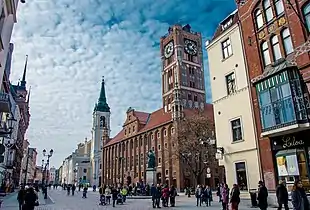








.JPG.webp)

_2010-07-17_039.jpg.webp)
